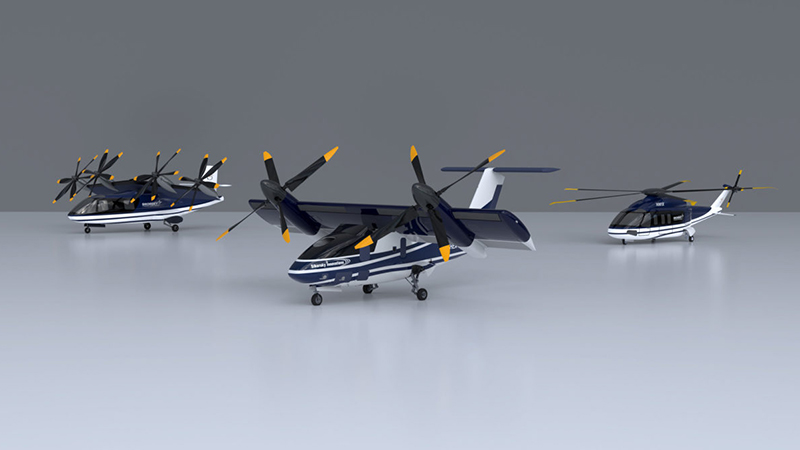

Anyone who’s been following the eVTOL/VTOL market will know that the biggest hurdle to overcome is aircraft range. An all-electric VTOL typically has a range of about 100km on a single charge, whereas a hybrid VTOL can push upwards of 400km.
But Sikorsky’s new concept aircraft plans to blow both of these figures out of the water, marking a major step forward in the VTOL industry. Below, we’ll look at how it’s achieved this and what it means for the future of VTOLs.
Sikorsky, a subsidiary of Lockheed Martin, recently announced a new family of concept VTOL. It includes three designs: a traditional helicopter, a quadcopter, and the one we’re interested in, a tilt-wing hybrid electric VTOL.
Information about how this will play out in the future is currently sparse. However, we do know that the eventual goal will be to include a 1.2MW turbo generator for the combined benefits of electric and traditional engine powertrains. Theoretically, this will result in the right combination of high speeds and impressive range. Sikorsky’s current target is a range of more than 925km.
But how will it achieve this considering Honda’s hybrid VTOL has a range of 400km? Well, the most obvious factor is the sheer size of the planned turbo generator. At 1.2MW, it’ll be bigger than the Honeywell 1MW turbo generator, which will be used in all kinds of aircraft.
Another important factor is the VTOL’s design. The inclusion of a tilt-wing design is useful for improving aerodynamics during horizontal flight. Many multi-rotor VTOL designs have relatively short range due, in part, to their focus on vertical lift. The Sikorsky concept, however, will theoretically look like any other propeller aircraft when in flight.
Tilting the entire wing offers an advantage during vertical flight, too, when compared to a tilt-rotor design. The slipstream created by the rotor’s thrust hits the wing at its smallest point (the same as in horizontal flight), meaning less energy is lost during lift.
When we’re looking at a hybrid engine range, this extra efficiency is an important saving. Although not a direct comparison, the Boeing V-22 Osprey loses around 10% of its thrust from wing interference during vertical lift. The tilt-wing design, therefore, will have a knock-on effect on the VTOL’s overall efficiency.
As we’ve discussed previously, there are plenty of niches to fill in the larger VTOL market. For example, this Sikorsky concept likely won’t be used for urban air mobility, but will find a viable space in longer-range journeys, such as airport or city-to-city transfers.
However, perhaps a more important thing to note is its contribution to the industry’s development of arguably its biggest hurdle. It can’t be overstated how much battery and power capabilities are holding back the wider VTOL industry. Other than mastering autonomous flight, it’s the one thing that’ll bottleneck the universal rollout of VTOL.
So, to theorise that a range of nearly 1000km is possible on a hybrid powertrain is a pretty big deal. As it stands, we don’t have loads of information on how Sikorsky will achieve this. But considering it’s currently testing a 600KW electric motor, and has the power of Lockheed Martin behind it, we can only assume this will be a perfectly achievable goal.